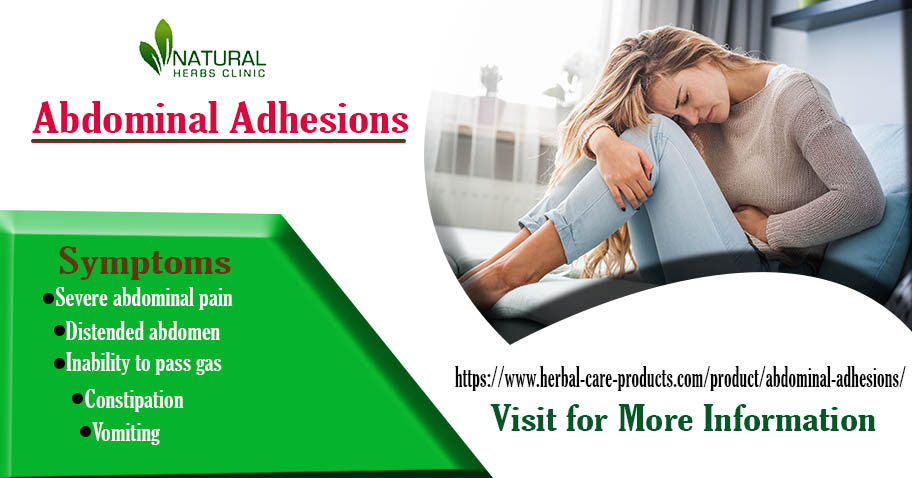Abdominal Adhesions Read the Complete Information about the Condition

Abdominal Adhesions Explained
Abdominal Adhesions occurs when adhesions restrict the normal movement of the intestines. This condition can lead to severe abdominal pain, bloating, vomiting, and other distressing symptoms.

Causes of Abdominal Adhesions
The primary cause of Adhesive Intestinal Obstruction is the formation of adhesions in the abdominal cavity. These adhesions can develop due to various reasons:
- Surgical Procedures: Adhesions are a common complication of abdominal surgery. Even with the utmost surgical skill and precision, the body’s natural response to tissue injury involves the formation of scar tissue.
- Inflammatory Conditions: Inflammation within the abdominal cavity, often seen in conditions like Crohn’s disease or diverticulitis, can trigger the development of adhesions.
- Infection: Infections in the abdominal region may lead to adhesion formation as the body attempts to heal itself.
Symptoms and Diagnosis
Recognizing adhesive intestinal obstruction is essential for prompt treatment. Common symptoms include:
- Severe abdominal pain
- Distended abdomen
- Vomiting
- Constipation
- Inability to pass gas
Diagnosis typically involves a combination of medical history, physical examination, and imaging tests such as X-rays or CT scans.
Scar Tissue Removal in Abdomen: Treatment Options
Conservative Treatment
In mild cases of adhesive intestinal obstruction, conservative management may be effective in Scar Tissue Removal in Abdomen. This approach includes fasting the patient to rest the intestines, along with providing intravenous fluids and electrolytes. However, this method may not always resolve the issue, and surgery may be necessary.
Surgical Intervention
When conservative measures prove insufficient, surgical intervention becomes the primary treatment option. During surgery, the surgeon carefully removes the adhesions to restore normal bowel function. This procedure is often performed laparoscopically, minimizing the risk of further adhesion formation.
Preventing Abdominal Adhesions
Preventing abdominal adhesions, especially after surgery, is a key concern for both patients and medical professionals. Some strategies to reduce the risk of adhesion formation include:
- Laparoscopic Surgery: Whenever feasible, opt for minimally invasive surgery techniques, which tend to result in fewer adhesions.
- Barrier Products: The use of specialized barrier products during surgery can help reduce adhesion formation.
- Proper Surgical Technique: Surgeons should employ meticulous surgical techniques to minimize tissue damage and subsequent adhesions.
-
Managing Abdominal Adhesions Pain
Abdominal adhesions, those bands of scar tissue that can form between abdominal organs and tissues, can often lead to discomfort and pain. While it’s essential to consult a healthcare professional for personalized advice and treatment options, there are some general strategies that can help alleviate abdominal adhesions-related pain.
1. Pain Medication:
Over-the-counter pain relievers such as acetaminophen or nonsteroidal anti-inflammatory drugs (NSAIDs) like ibuprofen can be effective in managing mild to moderate pain associated with abdominal adhesions. However, it’s crucial to use these medications as directed and consult a healthcare provider if you have any underlying medical conditions or concerns.
2. Heat Therapy:
Applying a heating pad or warm compress to the affected area can provide relief from abdominal discomfort. Heat can help relax the abdominal muscles and reduce pain.
3. Dietary Modifications:
Certain foods and dietary habits can exacerbate abdominal discomfort. Consider making dietary adjustments like:
- Eating smaller, more frequent meals to reduce strain on the digestive system.
- Staying hydrated to keep the digestive tract functioning smoothly.
- Avoiding foods that can cause gas or bloating, such as beans, carbonated beverages, and certain cruciferous vegetables.
4. Gentle Movement and Stretching:
Engaging in light physical activity, such as walking, can help stimulate bowel movement and alleviate discomfort. Gentle stretching exercises, like yoga, may also be beneficial in promoting abdominal flexibility and reducing pain.
5. Abdominal Massage:
A gentle abdominal massage can sometimes provide relief from adhesion-related pain. Ensure that the massage is performed by a trained professional or under the guidance of a healthcare provider.
6. Prescription Medications:
In more severe cases of abdominal adhesion-related pain, a healthcare provider may prescribe stronger pain medications or muscle relaxants to help manage symptoms. These should be used only as directed by a medical professional.
7. Surgical Intervention:
In cases where conservative methods fail to provide relief, surgical intervention to remove the adhesions may be necessary. This should be considered a last resort and discussed thoroughly with a surgeon.
Remember, it’s crucial to consult a healthcare provider for a proper diagnosis and personalized pain management plan. They can assess the severity of your condition and recommend the most appropriate treatments to address your specific needs. Pain relief strategies may vary from person to person, so working closely with a medical professional is essential for effective Adhesion Bowel Obstruction Natural Treatment.
In conclusion, abdominal adhesions and their potential complication, adhesive intestinal obstruction, are significant medical concerns that warrant attention. Understanding the causes, symptoms, and treatment options for these conditions is vital for both patients and healthcare providers.
By delving into the intricacies of abdominal adhesions and providing insights into their prevention and treatment, we hope to equip you with valuable knowledge. Remember that when it comes to abdominal adhesions, timely diagnosis and appropriate treatment are paramount in ensuring the best possible outcome.




